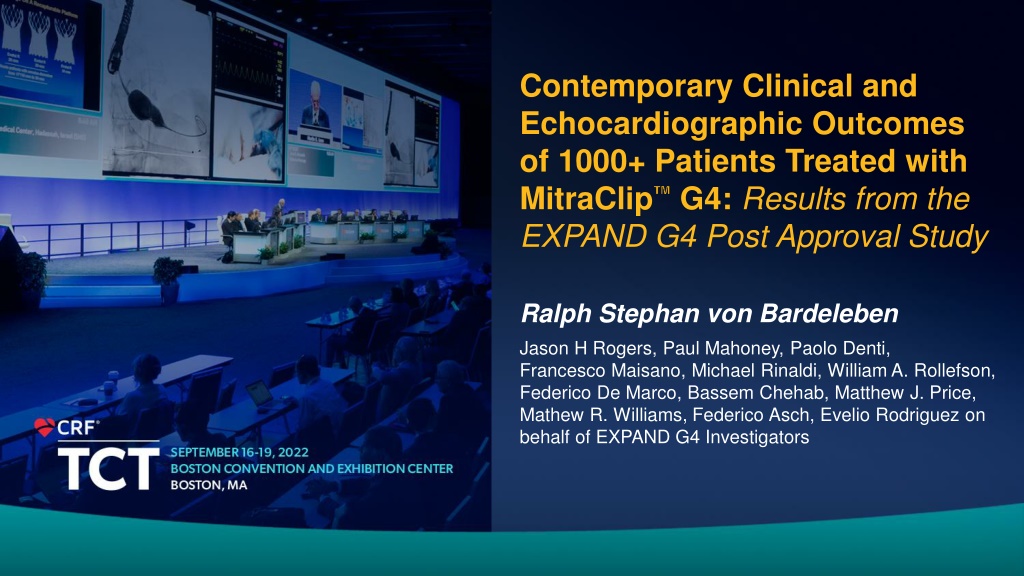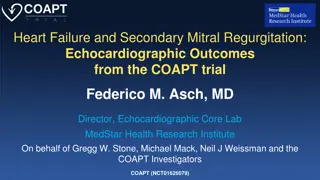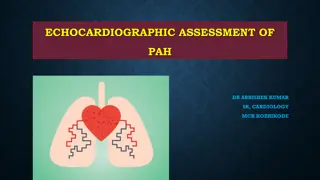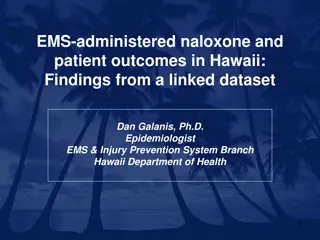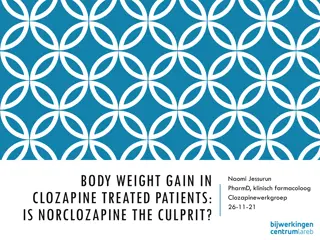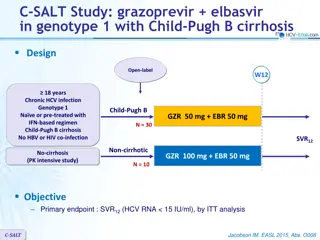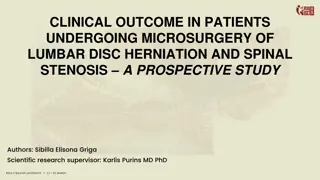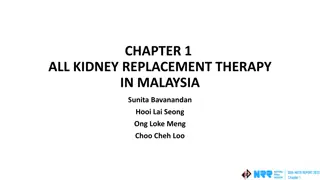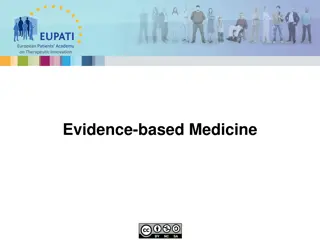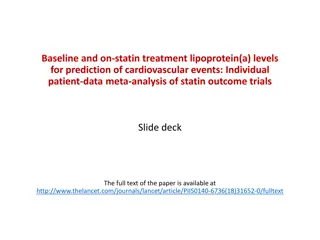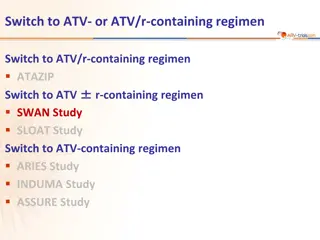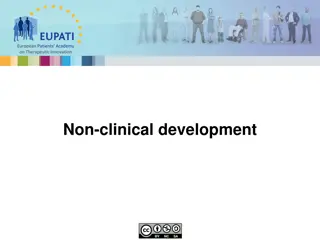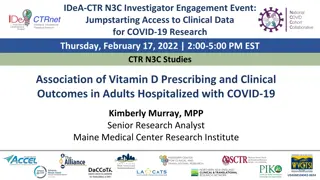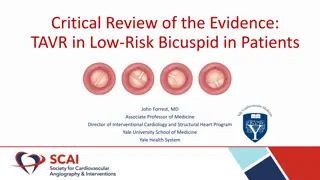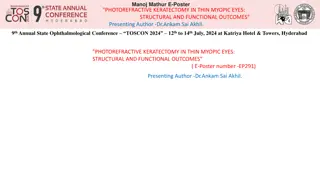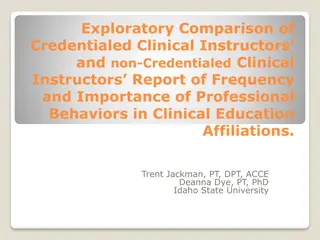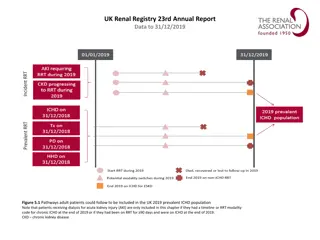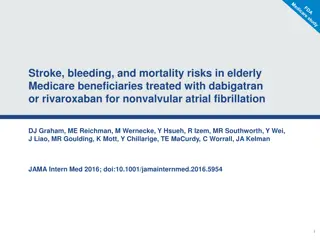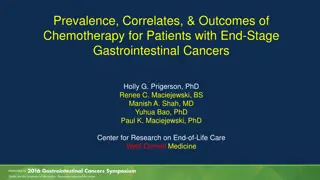Contemporary Clinical and Echocardiographic Outcomes of 1000+ Patients Treated with MitraClip G4: EXPAND G4 Study
This study focuses on the outcomes of 1164 patients receiving the MitraClip G4 system for PMR or SMR across multiple countries. The study aims to confirm the safety and effectiveness of the 4th generation MitraClip G4 system in a real-world setting. Key outcome measures include acute procedural success, occurrence of major adverse events at 30 days, MR severity, functional capacity, and quality of life assessments. The study design is a prospective, multi-center, real-world study with follow-up through discharge, 30-day visits, and annually up to 5 years. Baseline characteristics and echocardiograms are evaluated by an independent core laboratory.
Download Presentation

Please find below an Image/Link to download the presentation.
The content on the website is provided AS IS for your information and personal use only. It may not be sold, licensed, or shared on other websites without obtaining consent from the author. Download presentation by click this link. If you encounter any issues during the download, it is possible that the publisher has removed the file from their server.
E N D
Presentation Transcript
Contemporary Clinical and Echocardiographic Outcomes of 1000+ Patients Treated with MitraClip G4: Results from the EXPAND G4 Post Approval Study TCT Template Title 30 pt Bold Arial John Doe, MD Ralph Stephan von Bardeleben Jason H Rogers, Paul Mahoney, Paolo Denti, Francesco Maisano, Michael Rinaldi, William A. Rollefson, Federico De Marco, Bassem Chehab, Matthew J. Price, Mathew R. Williams, Federico Asch, Evelio Rodriguez on behalf of EXPAND G4 Investigators Subtitle 25 pt Arial Bold Italics
Disclosure Statement of Financial Interest I, Ralph Stephan von Bardeleben, DO NOT have a financial interest/arrangement or affiliation with one or more organizations that could be perceived as a real or apparent conflict of interest in the context of the subject of this presentation. Faculty disclosure information can be found on the app Faculty disclosure information can be found on the app
Background and Objectives The 4th generation MitraClip G4 System builds on the previous G3 system with two additional wider clip sizes: NTW and XTW, an independent grasping feature and improved clip deployment sequence NT NTW XT XTW The EXPAND G4 study was designed to confirm the safety and effectiveness of the 4th generation MitraClip G4 System in a contemporary, real-world setting This is the first complete analysis on core lab assessed 30-day outcomes from the entire study cohort of 1000+ subjects
Study Design EXPAND G4 is a prospective, multi-center, single arm, real-world study that has enrolled 1164 subjects with PMR or SMR receiving the MitraClip G4 system in the U.S, Europe, Canada, and Japan. Study Population Follow-up: Discharge, 30-day visits, and annually through 5 years 1164 Subjects Enrolled to undergo the MitraClip G4 Procedure Key Outcome Measures: Acute procedural success (survival to discharge with MR reduction to 2+) Occurrence of major adverse events at 30 days MR Severity, Functional capacity assessed through New York Heart Association (NYHA), Quality of Life assessed through Kansas City Cardiomyopathy Questionnaire Score (KCCQ) at 30 days 5 withdrawals 10 deaths 8 no visits 1141 Subjects Discharged 21 withdrawals 20 deaths 56 no visits 1044 Subjects with follow up at 30 days (91% Study Follow-up rate) All echocardiograms are assessed by an independent echocardiographic core laboratory (ECL)
EXPAND G4 is a Global, Real-World Study 60 sites across 10 countries (37 OUS sites)
Baseline Characteristics EXPAND G4 (N=1164) EXPAND1 (N=1041) Age (years) Male STS Replacement Score STS Repair Score Atrial Fibrillation Renal Failure Diabetes Hypertension Prior HF Hospitalization within 1 year Prior Myocardial Infarction Etiology: Primary MR Effective Regurgitant Orifice Area (EROA, cm2) Baseline TR of 3+ or 4+ Left Ventricular Ejection Fraction (LVEF, %) Left Ventricular End Systolic Volume (LVESV, mL) Left Ventricular End Diastolic Volume (LVEDV, mL) Complex* Mitral Valve Anatomy 77.5 9.1 55.9% (650) 7.6 6.2 5.9 6.2 58.2 (678) 26.1% (300) 25.6% (297) 77.6% (896) 43.6% (472) 19.5% (222) 41.6% (413/993) 0.31 0.14 (630) 8.1% (77/952) 48.4 16.4 (663) 78.1 54.3 (666) 140.4 62.1 (670) 13.5% (136/1008) 77.3 9.7 54.9% (571) 8.0 6.4 6.3 6.3 59.3% (614) 36.1% (374) 25.4% (261) 82.9% (859) 53.7% (502) 24.2% (246) 50.5% (422/835) 0.35 0.18 (615) 21.5% (175/813) 51.4 16.0 (836) 78.8 61.3 (838) 148.1 71.3 (836) 18.2% (156/858) 1 Kar et al. Core-Lab Adjudicated Contemporary Clinical Outcomes at 1 Year with MitraClip (NTR/XTR) System from Global EXPAND Study presented at TCT 2020. *Complex mitral valve anatomy includes presence of a wide jet, multiple jets, primary jet outside of A2P2, severely degenerative leaflets with large flail/prolapse gaps, minimal leaflet tissue, calcified landing zone, OR small valve.
Improved Procedural Outcomes EXPAND G4 (N=1164) EXPAND1 (N=1041) 98.9% (1030/1041) [98.1%, 99.5%] 98.0% (1141/1164) [97.1%, 98.7%] Implant Rate % (n/N) [95% Confidence Interval] 95.8% (985/1028) [94.4%, 97.0%] 96.2% (1099/1143) [94.9%, 97.2%] Acute Procedural Success (APS)* % (n/N) [95% Confidence Interval] Device Time (min) Median [Inter-Quartile Range] 35.0 [21.0, 54.0] 46.0 [30.0, 71.0] Procedure Time (min) Median [Inter-Quartile Range] 80.0 [54.0, 115.0] 77.0 [56.0, 104.0] Clip Rate Mean SD (N) 1.5 0.1 (1041) 1.4 0.6 (1164) EXPAND G4 demonstrates high procedural success rate with the shortest device and procedure times reported to date (24% reduction in device time compared to EXPAND) 1 Rottbauer et al. Contemporary Clinical Outcomes with MitraClip *APS defined as successful implantation of the MitraClip device with resulting MR severity of 2+ or less on discharge Echocardiogram per ECL. Device time, defined as time the SGC is placed in the intra atrial septum to the time the CDS is retracted into the SGC. (NTR/XTR) System: Core-lab Echo Results from +1000 Patient the Global EXPAND Study presented at PCR 2020.
G4 Clip Usage is Tailored to Patient Anatomy Number of Clips Used* 4% 3+ Clips 14 Clip Combinations in Procedures* NT + XT, 0.4% XT Only, 3.9% NT Only , 8.0% Other, 0.9% NTW Only , 26.1% 31% 2 Clips 65% 1 Clip XTW Only , 40.2% NTW + NT, 7.6% NTW + XT, 0.1% NTW + XTW, 2.5% XTW + NT, 4.3% XTW + XT, 6.1% A wide clip (NTW/XTW) was used in 88% of subjects treated 65% of subjects treated with 1 Clip (vs 55% in EXPAND) *1141 Subjects with at least 1 Clip implanted
Mitral Gradients with Wider Clips EXPAND G4 EXPAND1 All Clip Types NTW* XTW* 2.5 1.8 (766) 2.46 1.20 (262) 2.49 2.16 (356) 2.3 1.3 (678) Pre-procedure Mean MV Gradient, mm Hg 3.8 1.9 (781) 3.99 1.98 (277) 3.51 1.73 (390) 3.8 2.9 (803) 30-day Mean MV Gradient, mm Hg *NTW: At least 1 NTW and no XTW used; XTW: At least 1 XTW and no NTW used. Wider clips were not associated with increased mitral valve gradients post- procedure (assessed by ECL) 1 Rodriguez et al. Contemporary Clinical Outcomes with the MitraClip G4 System: Preliminary results based on the EXPAND G4 Study presented at TCT 2020.
Significant MR Reduction per ECL EXPAND G4 All Subjects p value <0.0001 100 2+: 98% 2% 7% 29% 1+: 91% 80 Population (%) 56% 60 40% Severe (4+) Moderate-Severe (3+) Moderate (2+) Mild (1+) Trace/None (0+) 40 20 26% 35% 5% 0 Baseline* (n=1025) 30 day (n=825) 91% of subjects achieved MR 1+ and 98% had MR 2+ at 30 days *Baseline MR Severity was reported as 3+/4+ for all subjects enrolled in EXPAND G4 and EXPAND per site assessment. ECL assessed MR severity based on ASE Guidelines (Zoghbi et al., J Am Soc Echocardiogr. 2003;16:777-802, 2017;30:303-371, 2019;32:431-475).
2+ Grade MR Reduction in Severe Baseline MR EXPAND G4 Subjects with Baseline MR 3+ (paired) 1% 100 2+: 97% 2% 8% 1+: 89% 80 42% Population (%) 60 60% Severe (4+) Moderate-Severe (3+) Moderate (2+) Mild (1+) Trace/None (0+) 40 58% 20 29% 0 Baseline 30 day (n=505) 89% of subjects achieved MR 1+ and 97% had MR 2+ at 30 days
Improved MR Reduction compared to EXPAND EXPAND1 EXPAND(paired) EXPAND G4 EXPAND G4 (paired) 1% 1% 1% 100 2% 2% 3% 2+: 97% 8% 2+: 97% 2+: 96% 14% 13% 80 42% 42% 1+: 89% 1+: 83% 1+: 83% % of population 60 60% 64% 69% 40 Severe (4+) Moderate-Severe (3+) Moderate (2+) Mild (1+) Trace/None (0+) 58% 58% 20 29% 19% 14% 0 Baseline 30 day (n=505) Baseline 30 day (n=411) 1 year (n=274) Compared to EXPAND (NTR/XTR), reduction to MR 1+ achieved in 89% vs. 83% (p=0.02), None/Trace MR achieved in 29% vs 19% (<0.001)
Improved Functional Class and Quality of Life KCCQ Score* NYHA Functional Class p value <0.0001 +18 25 Paired t-test p value <0.0001 1% 100 100 7% 16% 80 80 Population (%) KCCQ Score 62% 60 27% 60 I/II: 83% 40 40 70 52 20 20 36% 29% 2% 0 0 Baseline (n=982) 30 day (n=982) Baseline (n=1161) 30 day (n=1035) I III III IV 83% of subjects NYHA class I/II at 30 days +18 point improvement in KCCQ score at 30 days *Quality of Life (QoL) improvements assessed by Kansas City Cardiomyopathy Questionnaire Overall Score (KCCQ-OS).
30-Day Adverse Event EXPAND G4 (N=1158) All-cause Death 1.3% (15) Myocardial Infarction 0.2% (2) Stroke 0.0% (0) Non-elective CV Surgery for Device-related Complications Leaflet Adverse Events SLDA* 0.9% (10) 1.0% (12) *Single leaflet device attachment (SLDA) events in the EXPAND G4 study were assessed by the ECL based on procedural and follow-up images. Lowest 30 day all-cause mortality rate reported to date
Expanding the Spectrum of TEER Suitability A Heart Valve Collaboratory (HVC) consensus document proposed criteria defining TEER unsuitability to identify patients that may be appropriate for TMVR1 The EXPAND G4 study provides contemporary, real-world outcomes in patients treated with the MitraClip G4 Systemand is defining suitability criteria for TEER based on clinical evidence with MitraClip 1 Lim et al. (2021) Consensus Document on Non-Suitability for Transcatheter Mitral Valve Repair by Edge Therapy. Structural Heart.
EXPAND G4 Subjects Beyond HVC TEER Unsuitability Criteria1 Risk of Stenosis At least ONE of the following: Severe Annular Calcification Severe Leaflet Calcification Prior Mitral Annuloplasty MVA < 3.5 cm2 EXPAND G4 N=1164 Baseline Moderate MR or Less 5% Baseline MR Severity < 3+ assessed by ECL per ASE guidelines Risk of Inadequate MR Reduction 28% At least ONE of the following: Barlow s disease Bi-leaflet prolapse/flail Significant secondary jet Severe leaflet degeneration with large gaps Minimal leaflet tissue Significant cleft or scallop 5% Clinical outcomes of these patient groups will be presented by Dr. Jason Rogers Time: Sunday at 12:30 PM Location: Presentation Theater 2, Room 160 1 Lim et al. (2021) Consensus Document on Non-Suitability for Transcatheter Mitral Valve Repair by Edge Therapy. Structural Heart. Note that these anatomic characteristics were excluded in original EVEREST II RCT.
Limitations Only acute, 30-day procedural outcomes are presented, longer- term follow-up is ongoing Enrollment was based on site evaluation of MR, all echo data presented is based on central Echo Core Lab assessment
Conclusions This is the largest report on echo and clinical outcomes at 30 days in both primary and secondary MR patients treated with the latest MitraClip G4 System in a real-world setting. The results from the EXPAND G4 study indicates: Significant MR reduction to 1+ is achieved (91% in EXPAND G4) Shorter device times with MitraClip G4 (35 min vs. 46 min in EXPAND) Significant improvements in functional capacity and QoL at 30 days Wider clip sizes allow for treatment of greater range of anatomies while achieving lowest reported adverse event rates to date (1.3% all cause mortality at 30 days) 1 Kar et al. Core-Lab Adjudicated Contemporary Clinical Outcomes at 1 Year with MitraClip (NTR/XTR) System from Global EXPAND Study presented at TCT 2020.
Clinical Implications The EXPAND G4 study confirms the safety and effectiveness of the next generation MitraClip G4 system in primary and secondary MR patients in a contemporary, real-world setting. The EXPAND G4 study demonstrates that MitraClip G4 Enables tailoring the therapy to patients mitral valve anatomy Achieves consistent MR reduction with low adverse events Improves procedural efficiency with lower number of clips Expands the spectrum of TEER suitable patients
